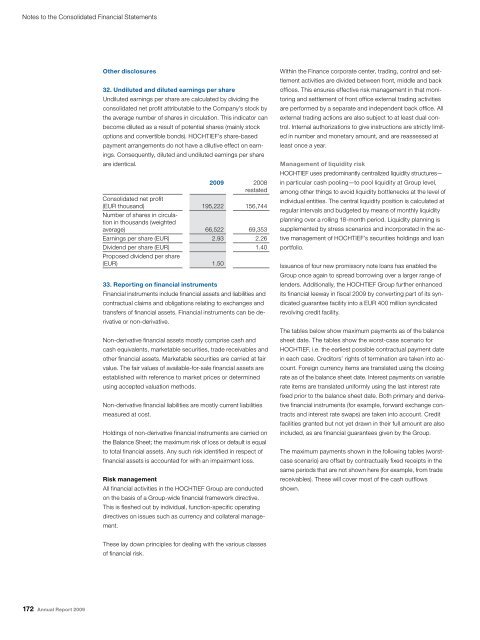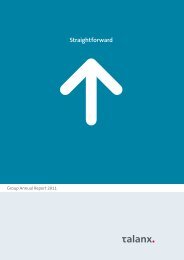ONE ROOF
ONE ROOF
ONE ROOF
You also want an ePaper? Increase the reach of your titles
YUMPU automatically turns print PDFs into web optimized ePapers that Google loves.
Notes to the Consolidated Financial Statements<br />
172 Annual Report 2009<br />
Other disclosures<br />
32. Undiluted and diluted earnings per share<br />
Undiluted earnings per share are calculated by dividing the<br />
consolidated net profit attributable to the Company’s stock by<br />
the average number of shares in circulation. This indicator can<br />
become diluted as a result of potential shares (mainly stock<br />
options and convertible bonds). HOCHTIEF’s share-based<br />
payment arrangements do not have a dilutive effect on earnings.<br />
Consequently, diluted and undiluted earnings per share<br />
are identical.<br />
33. Reporting on financial instruments<br />
Financial instruments include financial assets and liabilities and<br />
contractual claims and obligations relating to exchanges and<br />
transfers of financial assets. Financial instruments can be derivative<br />
or non-derivative.<br />
Non-derivative financial assets mostly comprise cash and<br />
cash equivalents, marketable securities, trade receivables and<br />
other financial assets. Marketable securities are carried at fair<br />
value. The fair values of available-for-sale financial assets are<br />
established with reference to market prices or determined<br />
using accepted valuation methods.<br />
Non-derivative financial liabilities are mostly current liabilities<br />
measured at cost.<br />
Holdings of non-derivative financial instruments are carried on<br />
the Balance Sheet; the maximum risk of loss or default is equal<br />
to total financial assets. Any such risk identified in respect of<br />
financial assets is accounted for with an impairment loss.<br />
Risk management<br />
All financial activities in the HOCHTIEF Group are conducted<br />
on the basis of a Group-wide financial framework directive.<br />
This is fleshed out by individual, function-specific operating<br />
directives on issues such as currency and collateral manage-<br />
ment.<br />
2009 2008<br />
restated<br />
Consolidated net profit<br />
(EUR thousand)<br />
Number of shares in circulation<br />
in thousands (weighted<br />
195,222 156,744<br />
average) 66,522 69,353<br />
Earnings per share (EUR) 2.93 2.26<br />
Dividend per share (EUR)<br />
Proposed dividend per share<br />
1.40<br />
(EUR) 1.50<br />
These lay down principles for dealing with the various classes<br />
of financial risk.<br />
Within the Finance corporate center, trading, control and settlement<br />
activities are divided between front, middle and back<br />
offices. This ensures effective risk management in that monitoring<br />
and settlement of front office external trading activities<br />
are performed by a separate and independent back office. All<br />
external trading actions are also subject to at least dual control.<br />
Internal authorizations to give instructions are strictly limited<br />
in number and monetary amount, and are reassessed at<br />
least once a year.<br />
Management of liquidity risk<br />
HOCHTIEF uses predominantly centralized liquidity structures—<br />
in particular cash pooling—to pool liquidity at Group level,<br />
among other things to avoid liquidity bottlenecks at the level of<br />
individual entities. The central liquidity position is calculated at<br />
regular intervals and budgeted by means of monthly liquidity<br />
planning over a rolling 18-month period. Liquidity planning is<br />
supplemented by stress scenarios and incorporated in the active<br />
management of HOCHTIEF’s securities holdings and loan<br />
portfolio.<br />
Issuance of four new promissory note loans has enabled the<br />
Group once again to spread borrowing over a larger range of<br />
lenders. Additionally, the HOCHTIEF Group further enhanced<br />
its financial leeway in fiscal 2009 by converting part of its syndicated<br />
guarantee facility into a EUR 400 million syndicated<br />
revolving credit facility.<br />
The tables below show maximum payments as of the balance<br />
sheet date. The tables show the worst-case scenario for<br />
HOCHTIEF, i.e. the earliest possible contractual payment date<br />
in each case. Creditors’ rights of termination are taken into account.<br />
Foreign currency items are translated using the closing<br />
rate as of the balance sheet date. Interest payments on variable<br />
rate items are translated uniformly using the last interest rate<br />
fixed prior to the balance sheet date. Both primary and derivative<br />
financial instruments (for example, forward exchange contracts<br />
and interest rate swaps) are taken into account. Credit<br />
facilities granted but not yet drawn in their full amount are also<br />
included, as are financial guarantees given by the Group.<br />
The maximum payments shown in the following tables (worstcase<br />
scenario) are offset by contractually fixed receipts in the<br />
same periods that are not shown here (for example, from trade<br />
receivables). These will cover most of the cash outflows<br />
shown.
















